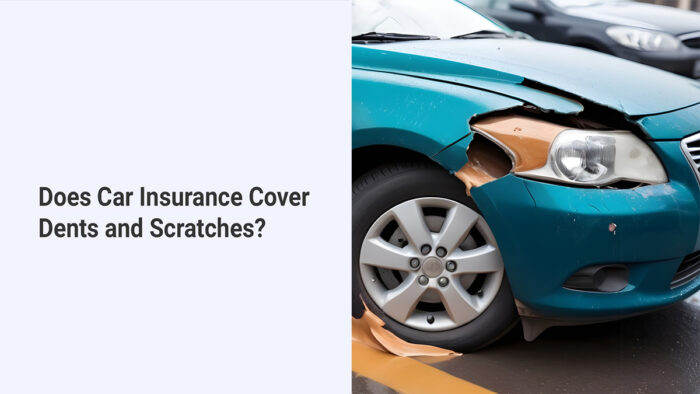Car insurance coverage for scratches and dents varies depending on the circumstances. Generally, car insurance will cover scratches and dents if they are caused by a covered scenario, like an accident or vandalism. However, standard car insurance typically does not cover wear and tear, including dents, scratches, door dings, and overall paint damage that may occur over time.

Filing a claim for minor damage like scratches and dents may not always be cost-effective if the repair costs are reasonable. It is essential to review your policy to understand what types of damage are covered and under what conditions. If the scratches or dents were caused by a covered peril in your policy, such as an accident or vandalism, then your car insurance is likely to cover the repair costs.
Car insurance can cover scratches and dents if they result from specific scenarios covered, like accidents or vandalism. However, it is crucial to check your policy details to determine the extent of coverage for cosmetic damages.
How Does Car Insurance Cover Scratches and Dents?
Car insurance covers scratches and dents based on the type of coverage you have. Collision coverage pays for damage from colliding with another car or object, while comprehensive coverage handles damage from incidents like vandalism, falling objects, or hail storms.
For example, if a deer dents your car, it is typically covered under comprehensive insurance. However, normal wear and tear, self-inflicted damage, or minor scratches may not be covered.
When deciding whether to file a claim for minor damage, consider factors like repair costs compared to your deductible, potential premium increases, and the impact on the aesthetics and value of your car. It’s essential to weigh these factors before deciding to make a claim, as they could affect your future premiums and overall costs.
When Should I Claim for Scratches and Dents on My Car?
When deciding whether to claim for scratches and dents on your car, consider factors like the type of coverage you have. Comprehensive coverage typically handles damage from incidents like vandalism, falling objects, or hail storms, while collision coverage pays for damage from colliding with another car or object.
It’s important to note that not all auto insurance policies cover scratches and dents, and factors like repair costs compared to your deductible, potential premium increases, and the impact on your car’s aesthetics and value should be considered before filing a claim.
If the damage significantly affects your car’s appearance or the repair costs exceed your deductible by a considerable amount, it may be worth filing a claim; otherwise, paying for minor repairs out of pocket might be more cost-effective in the long run.
Is it Worth Claiming on Car Insurance for Scratches and Dents?
Car insurance can cover scratches and dents, but whether it’s worth filing a claim depends on various factors. If the damage is minor and can be fixed for a reasonable cost that is less than your deductible, it might be more cost-effective to pay for the repairs out of pocket.
Filing a claim for minor damage could lead to an increase in your premiums, especially if the damage was caused by you. Comprehensive coverage typically handles damage from incidents like vandalism or falling objects, while collision coverage pays for damage from colliding with another car or object.
It’s crucial to consider the repair costs, deductible amount, potential premium increases, and the impact on your car’s aesthetics and value before deciding whether to file a claim for scratches and dents.
Car Insurance Policies that Cover Scratches and Dents
• Collision coverage
Collision coverage in car insurance helps pay for the cost of repairs to your vehicle if it’s hit by another vehicle or object, regardless of fault. It covers damages like hitting another vehicle, being hit by another vehicle, or hitting an object like a fence or sign.
However, collision coverage does not cover all types of damage, such as theft, vandalism, floods, fire, or hitting an animal. When considering whether to purchase collision coverage, factors like the value of your car, repair costs compared to your deductible, and potential premium increases should be taken into account.
If your car is financed or leased, collision coverage may be required by the lender to protect their interest in the vehicle. It’s essential to understand what collision coverage includes and excludes before deciding whether it’s worth adding to your auto insurance policy.
• Comprehensive coverage
Comprehensive coverage in car insurance is an optional policy that protects your vehicle from damages not caused by a collision. It covers losses like theft, vandalism, hail damage, and hitting an animal. However, it does not cover damages from hitting another vehicle or object, normal wear and tear, or damage caused by a collision.
Comprehensive coverage is essential for protecting your vehicle from various non-collision incidents like natural disasters, theft, and vandalism. It can be particularly valuable for new cars or in areas prone to specific risks like hail or theft.
When considering comprehensive coverage, factors such as the value of your car, repair costs, deductible amount, and potential premium increases should be taken into account to make an informed decision.
• Uninsured and underinsured motorist coverage
Car insurance provides financial protection if you are involved in an accident with a driver who either has no insurance or insufficient coverage to pay for your damages. Uninsured motorist coverage helps when the at-fault driver has no insurance, while underinsured motorist coverage assists when the at-fault driver’s liability limits are too low to cover your expenses.
These coverages can help pay for medical bills, lost wages, pain and suffering, car repairs, and other related damages that exceed the at-fault driver’s insurance limits. It is crucial to understand the differences between uninsured and underinsured coverage, as well as the specific requirements in your state regarding these coverages.
Adding uninsured and underinsured motorist coverage to your policy can provide essential protection in scenarios where you are hit by an uninsured or underinsured driver.
How to File a Scratch and Dent Insurance Claim
The insurance process for scratches and dents involves several crucial steps. To have your insurance cover the cost of scratch and dent repairs, you must report the damage to your car insurance company by filing a claim promptly. This can typically be done by calling your insurance company or visiting their website.
It’s essential to file your claim quickly, as insurance companies may deny claims for damages not reported in a timely manner. When deciding whether to make a claim, factors like repair costs compared to your deductible, potential premium increases, and the impact on your car’s aesthetics should be considered.
Having collision and comprehensive coverage under your auto insurance policy can provide the necessary coverage for scratches and dents, depending on how they occurred. Remember that filing a claim could lead to premium increases, so evaluating the costs and benefits is crucial before proceeding with a claim.
Conclusion
Based on the information gathered, the decision to claim car insurance for scratches and dents depends on various factors. Comprehensive and collision coverage are the primary policies that can cover such damages, but it is essential to assess the repair costs compared to your deductible.
Filing a claim promptly is crucial, as insurance companies may deny claims for damages not reported in a timely manner. Additionally, consider potential premium increases and the impact on your car’s aesthetics before deciding whether to proceed with a claim.
It’s important to understand the differences between uninsured and underinsured motorist coverage and how they can provide financial protection in case of accidents with inadequately insured drivers. Ultimately, evaluating the costs, benefits, and potential consequences of filing a claim for scratches and dents is vital to making an informed decision about utilizing your car insurance coverage effectively.



